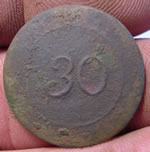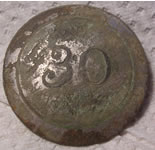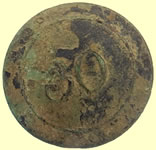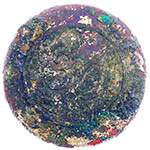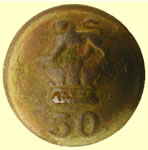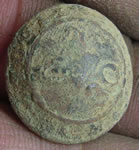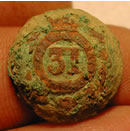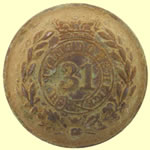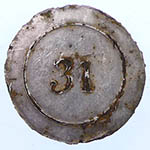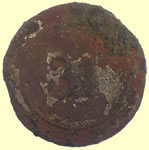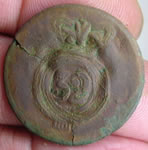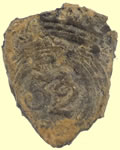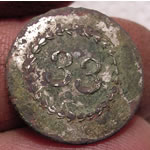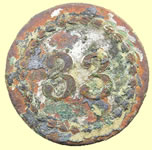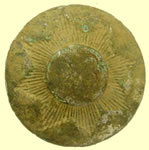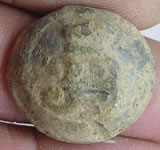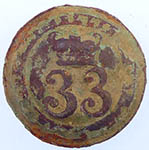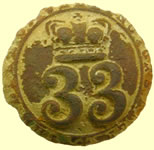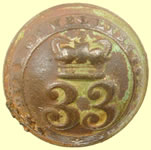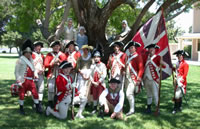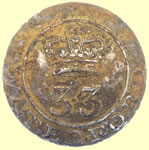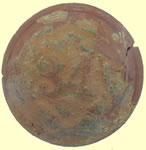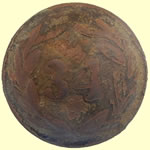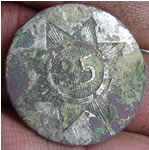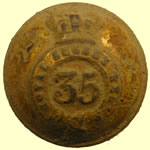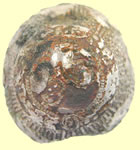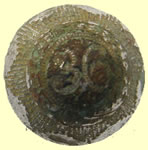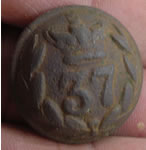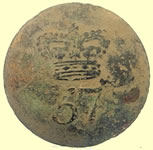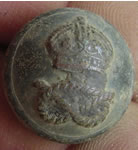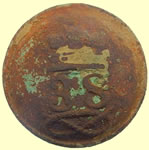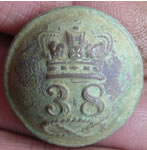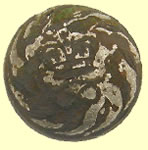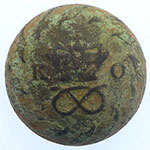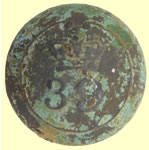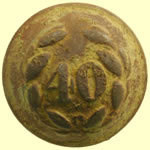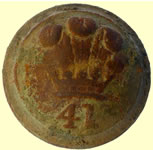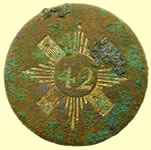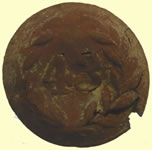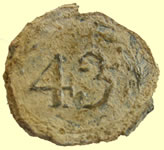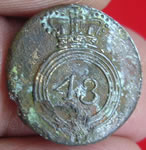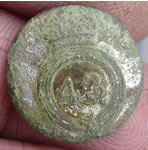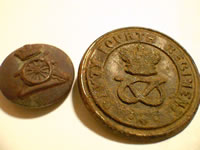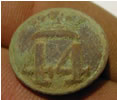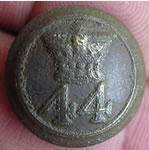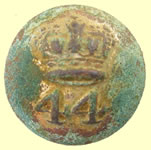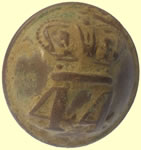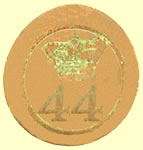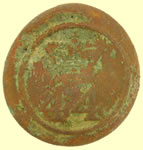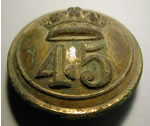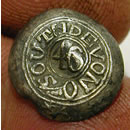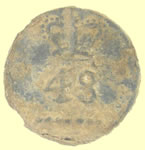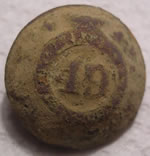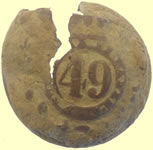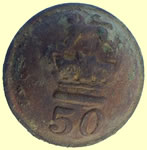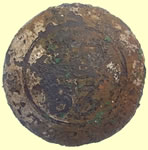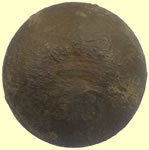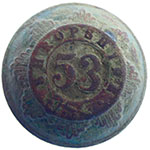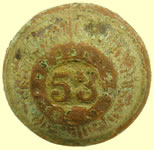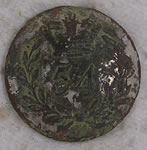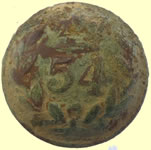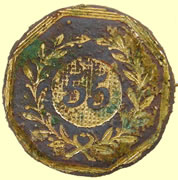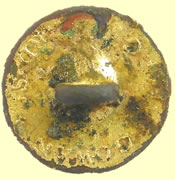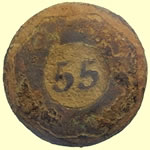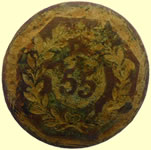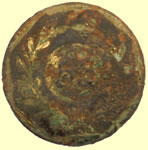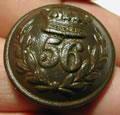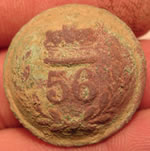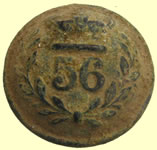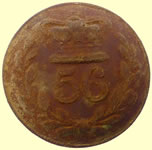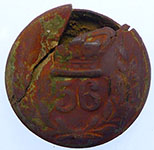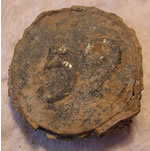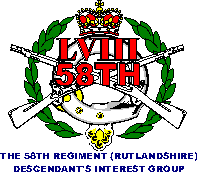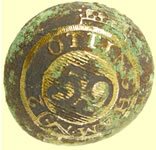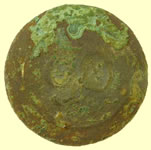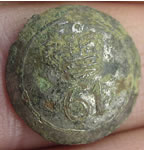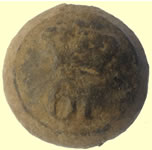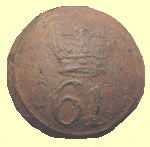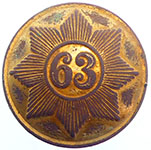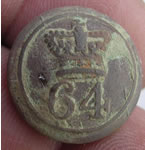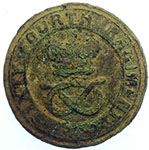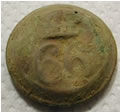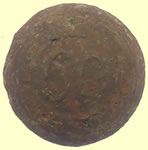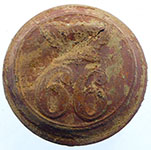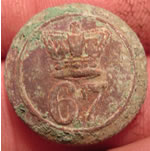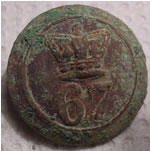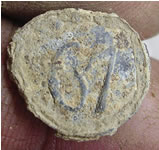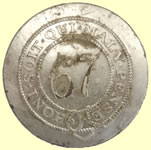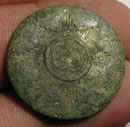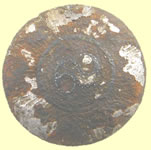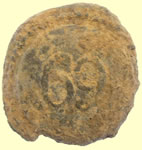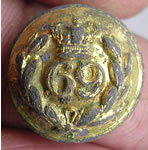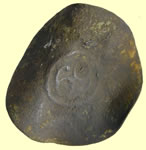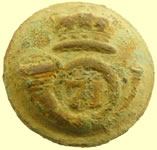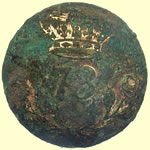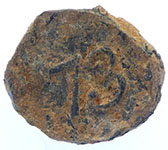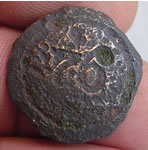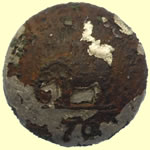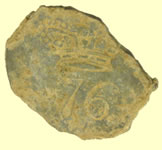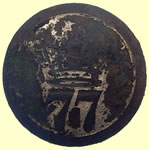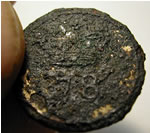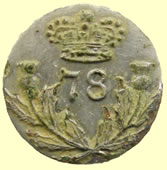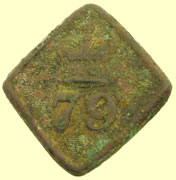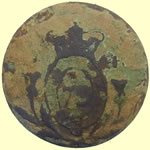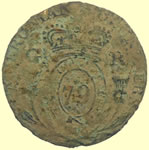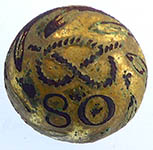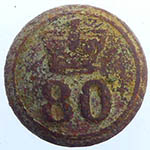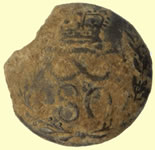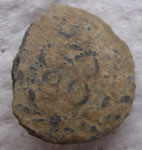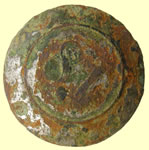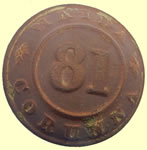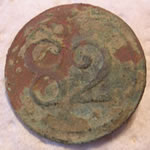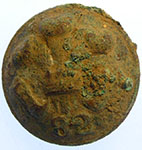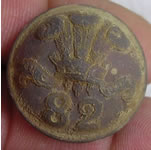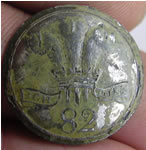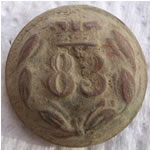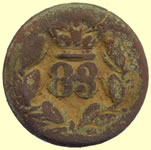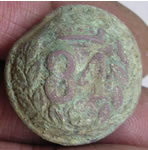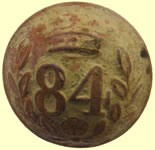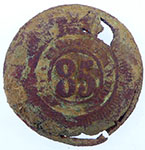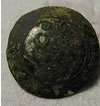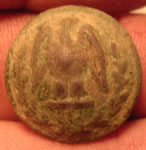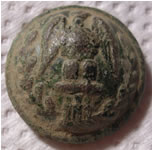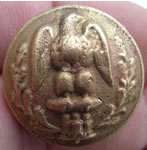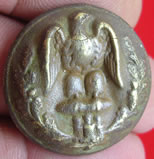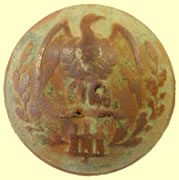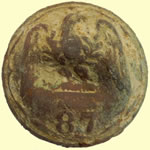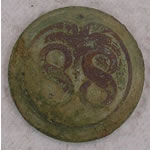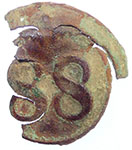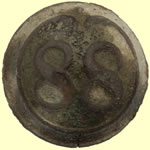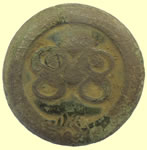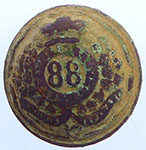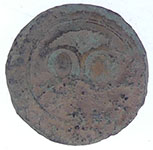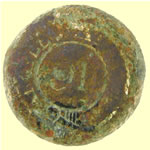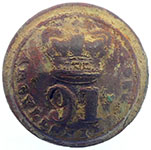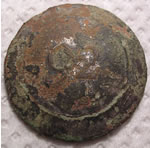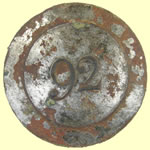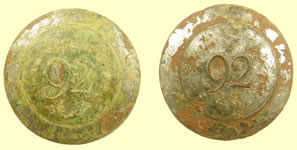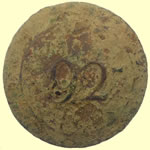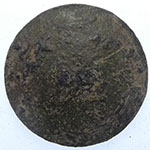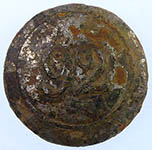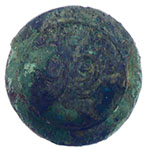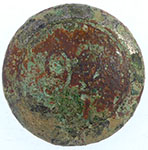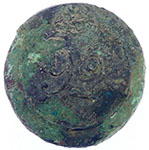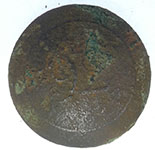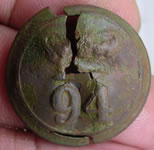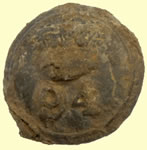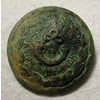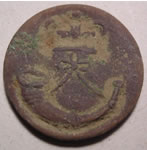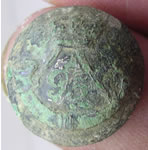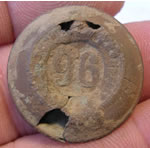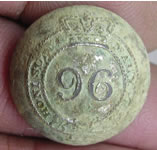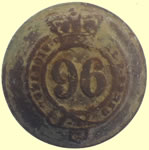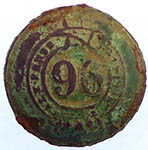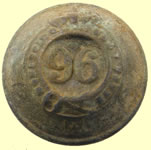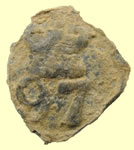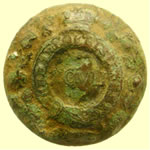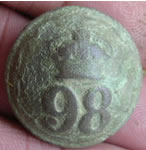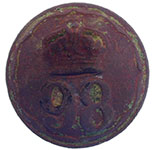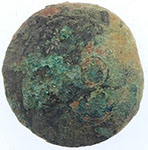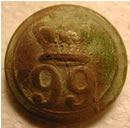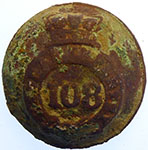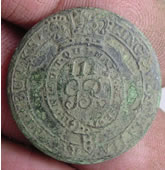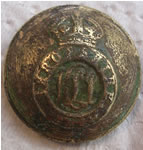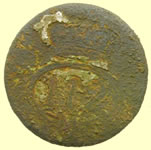

Metal detecting holidays in England with the World's most successful metal detecting club.20 years plus.
Twinned with Midwest Historical Research Society USA.
|
The end of a quarter-century of war with the French brought the usual post-war army cuts even though Britain had acquired a vastly larger empire. Some of these reductions proved premature, and the 94th, 95th, 96th, 97th, 98th, and 99th Regiments of Foot were added to the British Army in 1823-24. Contact Tim Burton our military button expert for his on line reference books |
|||||||
1st to 112th Regiment of foot buttons |
|||||||
|
Description: Crown over 1 with LOYAL SUFFOLK YEOMANRY on buckled strap Category: Yeomanry Cavalry; Type of button: Flat 20.5mm; Metal: Copper Alloy, silver plated ; Backmark: None ; Date: 1803-1815
Officer - 1794-1827
|
|
||||||
1st Regiment of Foot (Royal Scots) Officer - 1770-1812
German ? |
1st Regiment of Foot (Royal Scots) |
||||||
1809-1816 Description: Crown between 1st and L and above ESSEX Category: Local Militia; Type of button: Convex; Metal: Copper Alloy, silvered; Backmark:; Date: 1809-1816
|
Unrecorded one piece military button 1st Essex Local Militia The 1st Essex Local Militia were formed in 1809, this is the first of two known types to this unit |
||||||
|
Officer - 1770-1812
1st Regiment of Foot
(Royal)
Description:1 within lined rings Category: Regular Army; Type of button: Flat 22mm open backed ; Metal: Copper Alloy, gilt. Backmark:John Williams; Date: c1795-c1805
|
|||||||
|
Description: KDG on sunken eight pointed star surmounted by crown. Category:Dragoons Type of button: Flat; Metal: Copper Alloy gilded. Backmark:; Date: c1790-1830.
|
Pre 1812 THE 1ST. (KINGS) DRAGOON GUARDS
|
||||||
Description: Crown over LM with 2 below Category:English Infantry Militia Type of button: Flat ; Metal: Copper Alloy silvered. Backmark:; Date: c1793-1803 |
Leicestershire Militia 1793-1803 | ||||||
|
Officer - 1770-1812
O/R's - 1855-81
18thC 2nd regiment of foot regiment button (not in ref books)
Unrecorded example with legend
The seven Royal Garrison Battalions were re-named Royal Veteran Battalions in July 1804 Unrecorded example with legend - 'Veteran Battalion' The Second Regiment of Foot Guards i.e "The Coldstream Guards".
|
THE 2nd REGIMENT OF FOOT The Second Regiment of Foot Guards i.e "The Coldstream Guards". |
||||||
Description: 3 within circle surrounded by ESSEX LOCAL MILITIA Category: Local Militia; Type of button: Slightly convex; Metal: Copper Alloy, gilded; Backmark: S FIRMIN STRAND; Date: 1809-1816
3rd Loyal Militia
|
3rd Essex Local Militia
'3rd Essex Local Militia gilt (b/m: Charles Jennens. London).
This is the 3rd Reg't
of the Essex Local Militia. Tim'
|
||||||
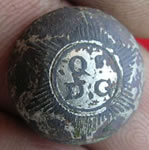 
|
2nd Queen's Dragoon Guards was founded in 1746, from The Princess of Wales's Own Regiment of Horse; redesignated 2nd Dragoon Guards (Queen's Bays) (1872); redesignated The Queen's Bays (2nd Dragoon Guards) (1921); amalgamated to form 1st The Queen's Dragoon Guards (1959). |
||||||
|
O/R's - 1780-1812
|
Pre 1820 3RD REGIMENT OF FOOT. / After 1881 :- The Buffs (East Kent Regiment) http://members.cavtel.net/brownrs/
|
||||||
|
Early one piece unrecorded 3rd 'Essex Local' Back mark Best Quality '3rd Essex Local Militia gilt (b/m: Charles Jennens. London).
This is the 3rd Reg't of the Essex Local Militia.
|
3rd
'Essex Local' |
||||||
|
Description: PoW feathers with DG either side and garter motto around. Category: Cavalry Type of button: Convex 22mm; Metal: Copper Alloy, gilt.Backmark: CHARLES JENNENS LONDON (Pow crest); Date: c1815-1820.
Description: PoW feathers with DG and ICH DIEN legend either side. Category:Dragoon Guards Type of button: Flat 22mm; Metal: Copper Alloy gilded. Backmark: None; Date: c1785-1815.
Description: PoW feathers with D Gds either side and ICH DIEN below. Category:Dragoon Guards Type of button: Flat 18mm; Metal: Copper Alloy gilded. Backmark: None; Date: c1770-1785.
|
3rd (Prince of Wales's) Dragoon Guards
|
||||||
|
Description: 'SURRY' written around crown on buckled eight pointed star Category: English Infantry Militia; Type of button: Flat ; Metal: Copper Alloy.; Backmark ; Date: c1790-1801
|
3rd Surry Militia The Surrey Militia (also spelt Surry) were reformed in 1763 before gaining the Royal Title in 1801. |
||||||
Description:Lion on ground over IV with legend KINGS OWN INFANTRY around. Category: Regular Army; Type of button: Convex 20mm ; Metal: Silver plated. Backmark:None; Date: c1790-c1800
Unrecorded types
Kings St Covent Gardens
4th Regiment of Foot ( The King's Own ) Officer - 1794-1811
Stunning find - 1787- 1793 4th Regiment of foot Post American Revolution period button Troiani B4.j
|
4th Regiment of Foot ( The King's Own )
An officer of the 4th Regiment of Foot c.1776-80 |
||||||
http://www.kingsown.net/about.htm When William of Orange landed at Torbay in 1688 the first regiment to support him was the 4th of Foot. In recognition of this the Regiment was given the unique distinction of wearing the Lion of England as its badge. The Regiment won its first battle honour at Namur in 1695 as part of King William's Army. Throughout the war of Spanish Succession the Regiment was employed on service with the fleet and in 1703 became part of the Royal Regiment of Marines. In 1743 the 34th of Foot were sent to Flanders at the outbreak of the War of Austrian Succession, conducting a famous rearguard action at Fontenoy on 30 April 1745. For this action it was awarded the right to emblazon a laural wreath on the Colours. In the Peninsular War both the 4th and 34th of Foot served with distinction. The 4th led the charge into the breach at the great fortress city of San Sebastian. On the 28th October 1811 at the battle of Arroyo Dos Molinos the 34th found themselves fighting their French opposite number, the 34eme Regiment de Ligne. Victory was total to the extent that the French lost their Drums and Drum Major's Mace. The Battle Honour "Arroyo Dos Molinos" is unique to the Regiment and to this day the original Drums and Mace are paraded on the anniversary of the battle. After Napoleon's escape from Elba the 4th of Foot crossed from England to Belgium and by marching forty eight miles in just over a day were able to take part in the Battle of Waterloo. In 1841 the 55th of Foot played a distinguished part in the Chinese wars, capturing an Imperial Chinese Dragon Standard at Nankin. It was awarded the right to bear the word 'CHINA' and the dragon device on the Colours.
|
|||||||
|
WWI type
Officer - 1855-1901
WWII type 1935-1952
|
THE 5TH. (PRINCESS OF WALES'S) DRAGOON GUARDS
First cuff button we have ever found
Description: Crowned Hannover Horse over V D.G with VESTIGIA NULLA RETRORSUM around. Category: Dragoons Type of button: Slightly Convex; Metal: Copper Alloy, silver gilded. Backmark: ; Date: c1780-1796.
|
||||||
|
Description:V within garter reading NORTHUMBERLAND REG crowned. Category: Regular Army; Type of button: Slightly convex 24mm ; Metal: Copper Alloy silver plated. Backmark:None ; Date: 1783-1790 0r 1799-1804
Description:V within eight pointed star. Category: Regular Army; Type of button: Slightly convex 22mm ; Metal: Copper Alloy silver plated. Backmark:FIRMIN & WESTALL ; Date: c1794-1811
1790 - 1830
O/R's - (Brass) - 1855-1856
1855-1881
|
British
5th Regiment of Foot, fought at Lexington-Concord and Bunker Hill. |
||||||
|
Description: Antelope over 6 within garter with motto surmounted by crown . Category: Regular Army; Type of button: Convex 19.5mm ; Metal: Copper Alloy, silver plated; Backmark: LEWIS INKSON LONDON ; Date: c1810-c1820
|
THE 6TH
REGIMENT OF FOOT. / After 1881 :- Royal Warwickshire Regiment
|
||||||
Pre 1940 |
6th Inniskilling Dragoons | ||||||
|
Officer - 1861-1866
1855- 1930 Princess Royal 7th Dragoon guards button
Description: QsO over 7 over LD on incised eight pointed star. Category:Light Dragoons Type of button: Flat 22mm; Metal: Copper alloy, silver plated. Backmark: None; Date: 1784-90. |
7th
Queen's Own
Hussars The 7th Queen's Own Hussars was a cavalry regiment in the British Army, first formed in 1690. It saw service for three centuries, before being amalgamated into the The Queen's Own Hussars in 1958. The regiment was first raised as The Queen's Own Regiment of Dragoons in 1690, by the regimenting of various independent troops, ranked as the 7th Dragoons and named for Queen Mary. The regiment was briefly disbanded in 1714, with its squadrons joining the 1st and 2nd Dragoons, but reformed the following year as The Princess of Wales's Own Regiment of Dragoons, named for Princess Caroline. The regiment was retitled on Caroline's coronation as Queen Consort, becoming the The Queen's Own Regiment of Dragoons in 1727, and formally titled as the 7th (The Queen's Own) Regiment of Dragoons in 1751. The regiment was designated light dragoons in 1783, becoming the 7th (The Queen's Own) Regiment of (Light) Dragoons, and as hussars in 1807 as the 7th (The Queen's Own) Regiment of (Light) Dragoons, with the title simplified in 1861 as the 7th (Queen's Own) Hussars. After service in the First World War, the regiment retitled as 7th Queen's Own Hussars in 1921. The regiment was transferred to the Royal Armoured Corps in 1939. The regiment survived the immediate post-war reduction in forces, but was slated for reduction in the 1957 Defence White Paper, and was amalgamated with the 3rd The King's Own Hussars, to form the The Queen's Own Hussars the following year. |
||||||
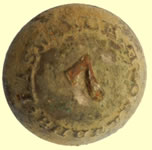 |
7th Regiment of foot | ||||||
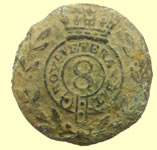 |
8th Royal Veterinary battion button | ||||||
1861-1920
|
9th Queens Royal Lancers The 9th Queen's Royal Lancers, or the Delhi Spearmen, were a cavalry regiment of the British Army. They are best known for their roles in the Indian mutiny of 1857 and for their part in the North African campaign of WW2 including the retreat to and the battle of El Alamein in 1942. |
||||||
|
1855-1881 |
10th Regiment of foot |
||||||
Description: 11 over (and off centre) LD Category:Cavalry Type of button: Flat; Metal: Copper alloy, silver plated.Backmark: None; Date: 1783-c1800. |
11th Light Dragoons Although the Light Troop had been disbanded some years before, each troop of the regiment had elements of light cavalry for recconaisance work. But in 1783 the whole regiment changed from heavy to light cavalry. For the first year, the 11th Light Dragoons, as they were now called, wore their red coats cut short but in 1784 they were issued with the distinctive dark blue uniform that was to set them apart from the rest of the British Army
The 11th became LD in 1783 and became Hussars in 1840, this style of button dates to the early part of this date range . |
||||||
Description: XI with REGIMENT in garter on crowned eight pointed star. Category: Regular Army; Type of button: Slight convex 22mm ; Metal: Copper Alloy; Backmark: I NUTTING & SON KING STREET COVENT GARDEN; Date: c1803-1820
|
11th Regiment of foot | ||||||
|
Description: 12 in front of crossed lances. Category:Cavalry Type of button: Convex 17mm; Metal: Copper Alloy.Backmark: NUTTING & SON KING ST COVENT GARDEN ; Date: c1816-c1825.
|
12th LANCERS The 12th Dragoons were
a British cavalry regiment raised in 1715 in Berkshire. They were
later renamed the 12th Lancers. They fought at Waterloo and during
the Great War were part of the 5th Cavalry Brigade. |
||||||
|
Description: 12 crowned within wreath. Category: Regular Army; Type of button: Convex 20mm ; Metal: Copper Alloy, gilt; Backmark: FIRMIN & WESTALL STRAND; Date: c1790-1810
|
12th Regiment of foot ( East Suffolk ) |
||||||
2 Stunning 13th Light dragoons unlisted buttons - pre 1800
'Still unrecorded, but I have it in
my book as the below' 13th Light Dragoons |
13th Light Dragoons
Light dragoons have always been rather special troops. They were first raised in the middle of the Eighteenth Century for reconnaissance and patrolling - in other words scouting - but soon acquired a reputation for courage and dash in the charge. Originally, each regiment of cavalry formed a light troop, but so successful was the idea that whole regiments were formed. The 15th Light Dragoons were the first ever (1759), and others quickly followed including the Eighteenth and Nineteenth. The Thirteenth, raised as heavy dragoons (mounted infantrymen) as early as 1715, were also converted to the light role. These light dragoon regiments fought all over the world in the half-century that followed, notably in India and North America. They distinguished themselves under the Duke of Wellington in Spain and Portugal in the Napoleonic wars, and three of them were present at the battle of Waterloo (1815). In the Crimean War (1854-56), the 13th Light Dragoons were in the forefront of the famous Charge of the Light Brigade, immortalized by Tennyson's poem of that name ("Into the valley of death rode the six hundred"). |
||||||
|
Officer - 1855-1881
|
THE 13TH REGIMENT OF FOOT. / After 1881 :- Prince Albert's (Somerset Light Infantry)
|
||||||
18thC Pewter button
19thC - XIV
|
The 14th was the Bedfordshire Regt of Foot until 1809 when it changed to the Buckinghamshire. This design style remained in use until 1838. |
||||||
|
Description: XV within eight pointed star. Category: Regular Army; Type of button: Flat ; Metal: Copper Alloy, silver plated; Backmark: None ; Date: c1810
1855-1881 |
THE 15TH REGIMENT OF FOOT. (York East Riding)
|
||||||
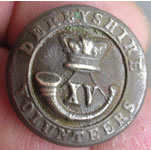 |
15th Derbyshire Volunteers | ||||||
Description: K over LD with 15 below on eight pointed star Category:Light Dragoons Type of button: Slightly convex; Metal: Copper Alloy, silver plated. Backmark: None; Date: c1769-1807. |
15th The Kings Light Dragoon guards | ||||||
|
O/R's - 1881-1901
|
THE 16TH. (THE QUEEN'S) LANCERS (1812 - 1922) The 2nd Light Horse was a British cavalry regiment raised in 1759. They first saw action at the siege of Belle Isle in 1761 and later fought in the American war of Independence. They were later renamed the 16th Lancers and earned the nickname 'Scarlet Lancers' because they were the only lancers to wear a scarlet tunic. They are the only British cavalry regiment to break an infantry square, which they did at Aliwal in the Punjab in January 1846. |
||||||
|
O/R's - 1855-1881
Officer's - 1782-1809
Rev wars period
|
THE 16TH. (THE QUEEN'S) LANCERS (1812 - 1922) The 2nd Light Horse was a British cavalry regiment raised in 1759. They first saw action at the siege of Belle Isle in 1761 and later fought in the American war of Independence. They were later renamed the 16th Lancers and earned the nickname 'Scarlet Lancers' because they were the only lancers to wear a scarlet tunic. They are the only British cavalry regiment to break an infantry square, which they did at Aliwal in the Punjab in January 1846. |
||||||
Description: Crowned 17 within laureal wreath. Category: Regular Army; Type of button: Flat 23mm ; Metal: Copper Alloy silvered; Backmark: S. FIRMIN STRAND; Date: c1800 |
17th (Leicestershire) Regiment of Foot button |
||||||
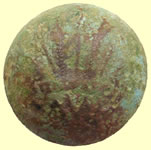 |
19thC Royal fuseliers button |
||||||
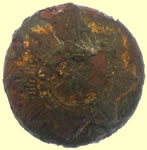 |
19thC Coldstream Guards button | ||||||
|
Description: Crowned XX within spray of leaves. Category: Regular Army; Type of button: Slightly convex 19mm ; Metal: Copper Alloy silvered; Backmark: Best Quality MS & ID; Date: 1800-1820
Officers button - 1776 pattern |
THE 20th REGIMENT OF FOOT East Devonshire Regiment pre 1800 This regiment was known as "Wolfe's Own" as Wolfe was once the colonel of this regiment. The regiment participated at both Louisbourg and Quebec during the Seven Years War in America. Governor Carleton also at one time served as a senior officer to this regiment. |
||||||
Unknown
21st Regt of Foot Description: Crowned 21 with thistle spray below. Category: Regular Army; Type of button: Slightly convex 25mm ; Metal: Pewter; Backmark: None; Date: c1800-1830
|
21st Regiment of foot - Rifle regiment ? | ||||||
The second style known to the 22nd (Cheshire) Regt of Foot. Description: 22 within contnued wreath of laurel design. Category: Regular Army; Type of button: Flat 22mm ; Metal: Copper Allot gilt; Backmark: McGOWAN KING STREET SOHO LONDON; Date: c1800-1810 |
22nd (Cheshire) Regt of Foot. | ||||||
|
Description: 23 at base of PoW feathers with ICH DIEN above Category: Regular Army; Type of button: Convex 13mm ; Metal: Copper Aloy silver plated; Backmark: I McGOWAN KING STREET SOHO LONDON ; Date: 1804-1814
1855-1881
|
THE 23RD REGIMENT OF FOOT
c 1800 / After 1881 :- The Royal Welsh Fusiliers
|
||||||
|
The South Wales Borderers (24th Foot)
|
||||||
Description: 25 on plain background. Category: Regular Army; Type of button: Convex 14mm ; Metal: Copper Alloy, gilt; Backmark: None; Date: c1809-1820
19thC Victorian Kings own royal border regiment
|
25th
Regiment of Foot |
||||||
|
Description: 26 within continuous leaf design. Category: Regular Army; Type of button: Flat 18.5mm; Metal: Copper Alloy, silvered; Backmark: Charles Jennens London +PoW feathers; Date: 1808-1820
Unknown style of the 26th Regiment of Foot regiment button |
26th
Regiment of Foot ( Cameronians ) |
||||||
|
Description: ENNISKILLEN over castle atop of 27. Category: Regular Army; Type of button: Flat 19mm; Metal: Copper Alloy, silvered; Backmark: None; Date: c1803-1820
Unrecorded in any book 27th Regiment of Foot ( Royal Inniskilling Fusiliers )
|
|||||||
|
1855-1881
Early one piece - not in ref books
Description: Lion surmounting crown atop of 28. Category: Regular Army; Type of button: Convex17mm; Metal: Copper Alloy, silvered; Backmark: I Mc GOWAN LONDON; Date: c1800-1820
19thC 28th Reg button
|
THE 28th
REGIMENT OF FOOT. Early Glostershire Regiment button The 28th became the North Gloucestershire Regt of Foot in 1782. |
||||||
|
Description: 29 within outer leave design. Category: Regular Army; Type of button: Flat17mm; Metal: Pewter; Backmark: None; Date: c1773-1787
|
Soldiers of the
29th Regiment of Foot as they would have looked |
||||||
|
Description: 30 within plain inner circle. Category: Regular Army; Type of button: Flat 22mm; Metal: Copper Alloy silvered; Backmark: S FIRMIN STRAND; Date: c1784-1797
Cambridge shire XXX Back mark C. Clancey & Co - Dublin 1817-47
Pre 1881 Victorian
WWII
|
30th (Cambridgeshire) Regiment of foot http://www.roll-of-honour.com/Regiments/30thRegimentofFoot.html
|
||||||
|
30th South. Mayo Reg't (Militia) Regular Militia ( Ireland ) Officer - (Gilt) - 1829-1836 |
||||||
|
O/R's - 1855-1881
Description: 30 within plain inner circle. Category: Regular Army; Type of button: Flat 22mm; Metal: Copper Alloy silvered; Backmark: S FIRMIN STRAND; Date: c1784-1797
|
THE 31ST
REGIMENT OF FOOT. c 1855 / After 1881 :- 1st Battalion The East Surrey
Regiment |
||||||
32nd regiment of foot ( Cornwall ) O/R's - 1855-1881
c1790-1810 |
THE DUKE OF CORNWALL'S LIGHT INFANTRY
(32nd & 46th Foot) The 32nd Regt of Foot gained the Cornwall title in 1782. This style had a long period of use by the Regt lasting until 1871 for other ranks and 1881 for officers. |
||||||
|
Description: 33 within inner continuous wreath type design. Category: Regular Army; Type of button: Flat 22mm; Metal: Copper Alloy, silver sheet; Backmark: S FIRMIN STRAND; Date: c1780-1795
Officer - 1848-1853
|
THE 33RD REGIMENT OF FOOT.
/ After 1881 :- 1st Battalion The Duke Of Wellington's (West Riding)
Regiment
Waterford Militia Between 1793 and 1815 the 33rd Light Infantry Regiment assembled in Waterford for a month’s training each year with the reservists being paid over this period. The concept was simple if there was a landing by a foreign force these men could be called upon to defend the country. Following the defeat of France in the Napoleonic wars this threat diminished and the militia was disbanded. |
||||||
Description: 34 within traditional wreath design. Category: Regular Army; Type of button: Convex 21mm; Metal: Copper Alloy, gilt; Backmark:FIRMIN & SONS 153 STRAND LONDON; Date: c1830-1840 |
34th Regiment of foot The 34th Regiment of Foot was an infantry regiment of the British Army, formed in 1702 and amalgamated with the 55th (Westmorland) Regiment of Foot, into The Border Regiment on 1 July 1881. |
||||||
|
Description: 35 within eight pointed star. Category: Regular Army; Type of button: Flat 23mm; Metal: Copper Alloy, silvered; Backmark:I McGOWAN KING ST SOHO LONDON; Date: 1782-1805
1808 - 35th Regiment of foot button
|
35th Regiment of foot web site Served in the Indian and Independence wars |
||||||
This is a fascinating one piece silvered unrecorded button find - The Button is the 36th Regiment of foot with the legend 'Leicester Regiment'. The Leicester Regiment were the 17th Regiment of foot ? and fought with Cornwallis at York town. Officer - 1800-1830
36th Regiment of foot button Description: Crowned 36 within French scroll design. Category: Regular Army; Type of button: Convex 18mm; Metal: Copper Alloy, gilt; Backmark: BAKER & SON BEDFORD ST COVT GARDEN; Date: c1808-1820 |
36th Regiment of foot |
||||||
|
O/R's - 1855-1881
Date: c1790-1810
|
37th (North Hampshire) |
||||||
38th Regiment of Foot ( 1st Staffordshire ) O/R's - 1855-1881
Description: Crowned 38 over 'Staffs' knot design. Category: Regular Army; Type of button: Convex 16mm; Metal: Copper Alloy, silvered; Backmark: Unreadable; Date: c1800-1820
Description: Crowned 38 over 'Staffs' knot design. Category: Regular Army; Type of button: Convex 16mm; Metal: Copper Alloy, silvered; Backmark: Unreadable; Date: c1800-1820
|
38th Regiment of Foot ( 1st Staffordshire ) |
||||||
Description: Crowned 39 within French scroll design. Category: Regular Army; Type of button: Convex 19mm; Metal: Copper Alloy; Backmark: I GOOD BIRMINGH; Date: c1800-1820 |
39th Regiment of Foot ( Dorsetshire ) |
||||||
Description: 40 within laurel wreath. Category: Regular Army; Type of button: Convex 20mm; Metal: Copper Alloy Gilt; Backmark: T SHAW LONDON; Date: c1820-c1830
|
The 40th (2nd Somersetshire) Regiment of Foot was an infantry regiment of the British Army, formed in 1717 and amalgamated into The Prince of Wales's Volunteers (South Lancashire Regiment) in 1881 | ||||||
|
O/R's - 1855-1881
|
c 1881
- THE 41st REGIMENT OF FOOT. / AFTER 1881 :- 1st Battalion The Welsh
Regiment The 41st Regt of Foot were the 41st Regt of Invalids from 1751-1787, the 41st Regt of Foot 1787-1831,then became the Welch Regt of Infantry from 1831-38, the 41st Welch Regt 1838-52, The Welch 1852-62 and the 41st Welsh Regt of Foot 1862-81 . |
||||||
Description: 42 within the Order of Thistle design. Category: Regular Army; Type of button: Flat 20mm; Metal: Copper Alloy gilt; Backmark: J SAYER WINCHESTER; Date: c1800-1820
|
42nd Regiment of foot Raised in 1739 and originally numbered the 43rd Regiment, the 42nd Foot is the most senior of the Highland Regiments
|
||||||
Description: 43 within laurel wreath. Category: Regular Army; Type of button: Slightly convex 19mm ; Metal: Pewter; Backmark: HERBERT LONDON ; Date: c1820-c1856
Description: 43 engraved within roped rim. Category: Regular Army; Type of button: Flat ; Metal: Pewter; Backmark: None ; Date: c1770-c1790 An early issue to the 43rd that was replaced for other ranks by a version showing the number within a laurel wreath.
Description: 43 within crowned lined garter. Category: Regular Army; Type of button: Flat 22mm ; Metal: Copper Alloy silvered; Backmark: FIRMIN & WESTALL ; Date: c1790-c1810
|
43rd LIGHT INFANTRY. / After 1881 :- 1st Battalion The Oxfordshire & Buckinghamshire Light Infantry) | ||||||
|
O/R's - 1820
Description: 44 under crown. Category: Regular Army; Type of button: Convex 19mm ; Metal: Copper Alloy silvered; Backmark: Possibly reads NUTTING; Date: c1800-1820
|
THE 44th
REGIMENT OF FOOT. / AFTER 1881 :- 1st Battalion The Essex Regiment |
||||||
|
Description: 45 under crown within French scroll. Category: Regular Army; Type of button: Convex 19mm ; Metal: Copper Alloy silvered; Backmark: FIRMIN & SONS; Date: c1820-1830
|
Pre- 1820
- THE 45th REGIMENT OF FOOT. / AFTER 1881 :- 1st Battalion The Sherwood
Foresters (Nottinghamshire & Derbyshire Regiment) |
||||||
|
Officer - 1830-1840
|
Silver 46th South Devon Regiment button(y) THE 46th REGIMENT OF FOOT. / AFTER 1881 :- 2nd Battalion The Duke Of Cornwall's Light Infantry |
||||||
18thC Unrecorded 48th regiment of foot button
Description: Crowned 48 over twisted bar. Category: Regular Army; Type of button: Convex 22mm ; Metal: Copper Alloy, gilt; Backmark: I NUTTING COVENT GARDEN; Date: c1790-1803 (Based on BM for this example)
|
The Northamptonshire Regiment was raised in 1741. It too was part of the Great Siege of GIBRALTAR from 1779-83 and was awarded the Castle and Key emblem. The most famous Battle Honour TALAVERA was gained in 1809 during the Duke of Wellington's campaigns against the French in the Peninsula. At the same time they earned the nickname "The Steelbacks" for their ability to show complete contempt when being flogged with the cat-o'-nine tails, then a normal method of administering punishments in the Army even for very minor crimes. |
||||||
|
Description: Crowned 49 within circle reading P CHARLOTTE OF WALES in union wreath Category: Regular Army; Type of button: Flat 18.5mm ; Metal: Copper Alloy, gilt; Backmark: PoW crest over S (Smith of Birmingham); Date: c1816-1820
|
THE 49th
REGIMENT OF FOOT |
||||||
Description: Crowned 50, lion atop within ring and semi-circle design. Category: Regular Army; Type of button: Flat 18.5mm ; Metal: Copper Alloy, silvered; Backmark: I NUTTING KING STREET COVENT GARDEN; Date: c1790-1803 |
50th Regiment of foot button The first regiment known as "50th Regiment of Foot" was raised in North America in 1755 by William Shirley, the British governor of Massachusets. It counted about 1,000 men. This regiment was disbanded on December 22 1756. In December 1755, a new regiment originally ranking as "52nd" was raised by Abercromby. In 1757, when the original "50th" and "51st" regiments of foot were disbanded. The "52nd" officially became the "50th Regiment of Foot". During the Seven Years' War, the regiment was under the command of:
|
||||||
Description: 52 crowned within wreath with OXFORDSHIRE written below. Category: Regular Army; Type of button: Convex 19.5mm ; Metal: Copper Alloy silvered; Backmark: FIRMIN & LANGDALE (1815-21); Date: C1800-1830 (Pattern in use) An officers example to the 52nd which was simply the 52nd Regt of Foot from 1757-1782, then Oxfordshire between 1782-1803, then Oxfordshire Light Infantry (1803-81). |
52nd Regiment of foot | ||||||
Officer - 1855-1881
19thC The 53rd (Shropshire) Regiment of Foot button
|
53rd (Shropshire) Regiment of Foot button 52nd who were in the West Indies from 1780-1800 . Known as the 53rd Regt of Foot from 1757-1782, then Shropshire between 1782-1881. |
||||||
|
Description: 54 under crown within wreath. Category: Regular Army; Type of button: Slightly convex 21mm ; Metal: Copper Alloy silvered; Backmark: FIRMIN & WESTHALL STRAND (1800-11); Date: c1800-1830 (design in use)
|
1805 THE
54th REGIMENT OF FOOT. / AFTER 1881 :- 2nd Battalion The Dorsetshire
Regiment |
||||||
Description: Raised 55 on chequered ground within raised octaganol design. Category: Regular Army; Type of button: Flat 23mm ; Metal: Copper Alloy gilt; Backmark: S.F; Date: c1778-1783
55th Regiment of foot
|
The 55th Regiment of Foot was a British army regiment raised at Stirling in 1755 and sent to America. In 1881 it became the 2nd Battalion of the Border Regiment. 55th (Westmoreland) Regiment of Foot The 55th went next to Niagara with General Prideaux, and took part in the repulse of a force of 1,800 French regulars and 500 Indians, which attempted the relief of the fort. The 55th was employed in various subsequent operations in connection with the conquest of the Canada's, and was detained in the country some years after the peace. At the beginning of the American War of Independence the regiment was again in America, and fought at Long Island, Brandywine, Germantown, and other early conflicts. In 1778 it was among the troops sent from New York to the West Indies.
|
||||||
|
Officer - 1844-1871
|
c 1800
THE 56th REGIMENT OF FOOT. / AFTER 1881 :- 2nd Battalion The Essex Regiment
|
||||||
|
The regiment started out as the 59th Regiment of Foot raised in Gloucester in 1755. After the disbandment of the 50th Regiment of Foot and the 51st Regiment of Foot in 1756, it became the 57th Regiment of Foot. In 1782, it was given a county connection, becoming the "57th (the West Middlesex) Regiment of Foot". The 57th Regiment earned their nickname of "the Die Hards" after their participation in the Battle of Albuera, one of the bloodiest battles of the Peninsular War, fought on 16 May 1811 |
||||||
|
Officer - 1757-1800
|
58th (Rutlandshire)
1740.....the
58th Regiment of Foot |
||||||
|
O/R's - 1782-1810
|
They served in the American
war of Independence and later became the 2nd Battalion of the East
Lancashire Regiment. |
||||||
O/R's - (Engraved) 1757-1815
An officers example to the 60th, known as the 60th Royal American Regt of Foot from 1757-1815, then Royal American LI 1815-1824, before becoming Duke of York's Own Rifle Corps and then the KRRC 1830-81. Description: Crowned 60 within strap reading HONI SOIT QUI MAL Y PENSE. Category: Regular Army; Type of button: Convex 20mm ; Metal: Copper Alloy silvered; Backmark: None Date: c1785-1800
|
60th Regiment of Foot ( Royal American ) |
||||||
|
O/R's - 1855-1881
|
61st Regiment of foot button The 61st (South Gloucestershire) Regiment of Foot was an infantry regiment of the British Army, created in 1758 and amalgamated into The Gloucestershire Regiment in 1881. |
||||||
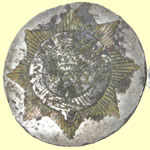 |
Unrecorded 62nd Regiment of foot - LXII Wiltshire Regiment - officers button |
||||||
Description: 63 incised within eight pointed star. Category: Regular Army; Type of button: Flat 22mm ; Metal: Copper Alloy silvered; Backmark: I McGOWAN GERRARD ST LONDON Date: c1800-1820 An officers example to the 63rd unusally with incised rather than raised numerals, known as the 63rd Regt of Foot 1758-1782 and then West Suffolk 1782-1881. |
63rd Regiment of foot | ||||||
|
1855-1881
Unknown 64th Regiment of foot button
|
THE 64th REGIMENT OF FOOT |
||||||
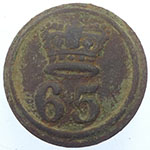 |
65th Regiment of foot button 2nd Yorkshire North Riding 1782-1881. |
||||||
|
1855-1881 |
1855-1881
- THE 66th REGIMENT OF FOOT. / AFTER 1881 :- 2nd Battalion Princess
Charlotte Of Wales's (Royal Berkshire Regiment) |
||||||
|
Officer - 1845-1855
Pre 1800
Description: 67 within inner strap reading HONI SOIT QUI MAL Y PENSE. Category: Regular Army; Type of button: Slightly convex 22mm ; Metal: Copper Alloy, silvered; Backmark: S FIRMIN STRAND Date: c1790-1820 An officers example to the 67th who were known as the 67th (South Hampshire) Regt of Foot from 1782-1881.
|
THE 67th REGIMENT OF FOOT The 1st South Hampshire Regiment was formed in 1782 of the old 67th Foot. The regiment won acclaim in India and was commemorated with the Royal Tiger on the regimental badge. They later became the 2nd Battalion of the Hampshire Regiment |
||||||
Description: 68 within wreath sprigs and outer rims of beads and florets. Category: Regular Army; Type of button: Flat 21mm ; Metal: Copper Alloy, silvered; Backmark: NUTTING & SON KING ST COVENT GARDEN Date: c1803-c1808 |
68th Regiment of foot | ||||||
|
Officer - 1770-1782
1855 - 81 69th Regiment of foot 1832-1912
THE 69th REGIMENT OF FOOT Officer - 1770-1782
|
THE 69th REGIMENT OF FOOT. / AFTER 1881 :- 2nd Battalion The Welsh Regiment officers button(b)
|
||||||
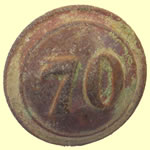 |
70th Regiment of foot | ||||||
1855-1881 |
The 71st Regiment of Foot was a Highland regiment in the British Army, which in 1881 became the 1st Battalion The 71st Regiment of Foot was first formed in 1758 from the 2nd Battalion, 32nd Regiment of Foot |
||||||
1797-1811
|
73rd Regiment of foot button The 73rd Regiment of Foot was an infantry regiment of the British Army, raised in 1780. Under the Childers Reforms it amalgamated with the 42nd Regiment of Foot to form the Black Watch (Royal Highlanders) in 1881. |
||||||
|
1766-1780 THE 76th
REGIMENT OF FOOT |
1766-1780
THE 76th REGIMENT OF FOOT. / AFTER 1881 :- 2nd Battalion The Duke Of
Wellington's (West Riding Regiment) |
||||||
Officer - 1845-1855 |
77th Regiment of foot button
The 77th (East Middlesex) Regiment of Foot (The Duke of Cambridge's Own) was a line regiment of the British Army from 1787 to 1881 |
||||||
|
Officer (Silver)-
1793-1810 |
Pre 1820
THE 78th REGIMENT OF FOOT. / AFTER 1881 :- 78th Highlanders The 78th Highlanders (Ross-shire Buffs) were formed in 1756 as the 2nd Highland Battalion and reformed in 1793 as the 78th Highlanders and joined with Fraser's Highlanders in 1881 to form the Seaforth Highlanders.
|
||||||
O/R's (W/M) - 1830-1855
1804-1820 79th Regiment of foot button 79 enclosed within strap, crowned with CAMERONIAN VOLUNTEERS above. An officers example to the 79th who were first the 79th Royal Liverpool Volunteers between 1778-1784, then Cameron Highlanders 1804-73 and Queen's Own Cameron Highlanders 1873-1881.
|
79th Regiment of Foot ( Cameron Highlanders ) |
||||||
80th Regiment of foot button Description: 80 under Staffs knot under crown within wreath. Category: Regular Army; Type of button: Convex 18mm ; Metal: Copper Alloy gilt; Backmark: C JENNENS LONDON Date: 1820-1830
|
80th Regiment of foot button | ||||||
Description: 81 within single inner line. Category: Regular Army; Type of button: Slightly convex 17mm ; Metal: Copper Alloy silvered; Backmark: I NUTTING COVENT GARDEN Date: 1793-1807 |
81st Regiment of Foot Loyal Lincoln Volunteers The 81st Regiment of Foot (Loyal Lincoln Volunteers) was an infantry regiment of the British Army, raised in 1793 and amalgamated into The Loyal North Lancashire Regiment in 1881. |
||||||
|
1855-81
19thC 82nd Regiment of foot button The design to the 82nd remained largely unchanged until 1881, from 1793 until 1881 the unit was he 82nd (Prince of Wales's Volunteers) Regiment of Foot. |
82nd (Prince of Wales Volunteers) Regiment of foot The 82nd Hamilton Regiment The 82nd
Regiment, also known as the Hamilton Regiment, was assembled in 1778
in Scotland. As the thirteen American colonies had decided on independence
from Great Britain, the 8th Duke of Hamilton was appointed to form a
regiment to reinforce its troops in North America. Potential recruits
from the Lanarkshire district were plied with guineas and port to join
the regiment. In addition, a detachment of soldiers enlisted for service
in the 42nd and 71st regiments, the Black Watch and the Fraser Highlanders,
were ordered into the 82nd. They refused and were convicted of mutiny.
King George III pardoned them, perhaps on the condition they serve in
the 82nd regiment. The land
was surveyed and divided into lots for the soldiers to draw their number.
While some sold their lots without seeing them, others visited the lots
and promptly returned to Halifax to re-enlist.
|
||||||
|
Description: 82 under Prince of Wales feathers. Category: Regular Army; Type of button: Slightly convex 22mm ; Metal: Copper Alloy silvered; Backmark: CHARLES JENNENS LONDON Date: c1808-1820
|
|||||||
|
O/R's - 1855-1881
|
THE 83rd REGIMENT OF FOOT 83rd (County
of Dublin) |
||||||
|
|
84th
Regiment of Foot ( York & Lancaster ) |
||||||
19th C |
85th Regiment of foot regiment button Raised in 1793 as the Bucks Volunteers, then BV Light Infantry added in 1808, BV Duke of York's Own LI 1815-21, BV Kings LI 1821-27 then 85th (The Kings LI) Regiment 1827-1881. |
||||||
|
Officer (Silver) -
1794-1809 |
Post 1795 THE 86th REGIMENT OF FOOT. / AFTER 1881 :- 2nd Battalion The Royal Irish Rifles
|
||||||
|
|||||||
|
|
87th
Regiment of Foot |
||||||
|
Description: 88 within French scroll with dot. Category: Regular Army; Type of button: Flat 19mm ; Metal: Pewter; Backmark: NUTTING LONDON Date: c1800-1871
|
88th Regiment
of Foot
88th (Connaught Rangers) Regiment of Foot |
||||||
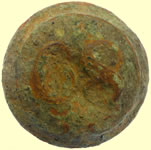 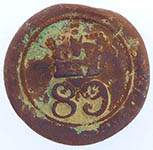 |
89th Regiment of foot button | ||||||
Date: c1820-1840
|
90th Regiment of foot button Raised 1794 |
||||||
Description: Crowned 91 with ARGHYLSHIRE REGT on buckled strap. Category: Regular Army; Type of button: Convex 15mm ; Metal: Copper Alloy silvered; Backmark: None Date: c1820-c1830
91st Regiment of foot- Argyllshire Highlanders O/R's (Brass) - 1802-1881 |
91st Regiment of foot- Argyllshire Highlanders |
||||||
|
Description: 92 within plain inner circle. Category: Regular Army; Type of button: Convex 15mm ; Metal: Copper Alloy silvered; Backmark: EXTRA STRONG PLATED Date: c1820-1840
|
THE 92nd REGIMENT OF FOOT
|
||||||
 |
The 93rd RegimentThe 93rd Regiment was raised three times before it became the Sutherland Highlanders. Sutherland FenciblesThe 1st Sutherland Fencibles were raised in Scotland from the area of Sutherland and Caithness in 1759 and disbanded in 1763 by Lord Reay. 1779: 2nd Sutherland Fencibles raised by Elizabeth, Countess of Sutherland (done in practice by Lt. Col. William Wemyss of Wemyss). 1793: 3rd Sutherland Fencibles raised by Wemyss. Served in 1798 Irish Rebellion. Disbanded April 1799 at Ft. George. Upon the disbandment of the two regiments in 1799, the new 93rd Regiment was recruited from the recently disbanded Sutherland Fencibles by their old colonel William Wemyss, at this time a Major General in the British Army, on behalf of his 16 year old cousin Elizabeth, Countess of Sutherland. |
||||||
94th regiment of foot O/R's (Brass) - 1802-1881 No buttons of the 94th are listed in any reference book
|
94th regiment of foot The regiment was raised in 1793 from the men of Connacht by John Thomas de Burgh, 13th Earl of Clanricard. In 1881, the 88th (Connaught Rangers) Regiment of Foot (which formed the 1st Battalion) and the 94th Regiment of Foot (which formed the 2nd Battalion) were amalgamated. The amalgamation of the two regiments into one was part of the British Government's Childers Reforms of the British Armed Forces which was, in turn, a continuation of the Cardwell Reforms implemented in 1879. At that time five infantry battalions were given Irish territorial titles. |
||||||
|
Kings Royal Rifle Corp 1872 - 1939
|
The Rifle
Brigade 1812 95th
Regiment of Foot (Riflemen)
The Kings Royal Rifle Corp 1872 - 1939 Also worn by The Rifle Brigade
|
||||||
|
Description: 96 crowned within buckled srap with order of garter motto. Category: Regular Army; Type of button: Convex 19mm ; Metal: Copper Alloy silvered; Backmark: CHARLES JENNENS LONDON (with PoW crest) Date: 1830-1881
O/R's (Pewter) - 1793-1855 |
96th (Queen's Own Germans) Regiment of Foot 1824 96th
Regiment of Foot
|
||||||
18th pewter button
O/R's - (Brass) - 1855-1881
XCVII regiment button The 97th (The Earl of Ulster's) Regiment of Foot was an infantry regiment of the British Army, formed in 1824 and amalgamated into The Queen's Own (Royal West Kent Regiment) in 1881.
|
Prior to 1800, three unconnected Foot Regiments bore the identification number of 97th Foot. The first 97th Regiment of Foot was raised in c1760 and disbanded in 1763. A second regiment was raised in 1780 under Colonel Samuel Stanton and disbanded in 1783. A third 97th Regiment of Foot was formed in 1794 under Sir James Grant, and disbanded in 1796.
In 1805, a new 97th Foot was formed from the Queen's German Regiment (or Queen's German Infantry; originally formed in 1798 as the Minorca Regiment).
In 1816 this 97th Foot Regiment was renumbered the 96th Foot (thus replacing the existing 96th Foot which, also in 1816, was renumbered 95th).
In 1816 when the existing 97th Regiment of Foot was renumbered 96th Foot, the 98th Regiment of Foot was renumbered 97th Foot before being disbanded in 1818.
In 1824, another 97th Foot was formed: the 97th (The Earl of Ulster's) Regiment of Foot. This continued until 1881 when this regiment was linked to the 50th (Queen's Own) Regiment of Foot to form The Queen's Own Royal West Kent Regiment.
|
||||||
|
98th (Prince of Wales's) Regiment of Foot
|
||||||
Officer 1824-1855
Description: 98 within plain inner circle. Category: Regular Army; Type of button: Convex 15mm ; Metal: Copper Alloy silvered; Backmark: EXTRA STRONG PLATED Date: c1820-1840
|
|||||||
|
O/R's (Brass) - 1855-1881
|
1823-24
- THE 99th REGIMENT OF FOOT. / After 1881 :- 2nd Battalion The Duke
Of Edingburgh's (Wiltshire Regiment) (r) |
||||||
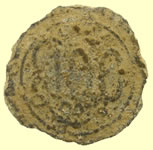 |
100th Regiment of foot button Prince Regent's County of Dublin Regiment Raised in Ireland in 1804 for service in the Napoleonic Wars |
||||||
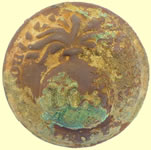 |
Great find Unrecorded 103rd Regiment of foot button Royal Genadiers button ? |
||||||
Description: Crown over 106 with NORWICH VOLUNTEERS around edge. Category: Regular Volunteers; Type of button: Flat; Metal: Copper Alloy, gilded.; Backmark: ; Date: 1794-1795 |
106th Ipswich volunteers |
||||||
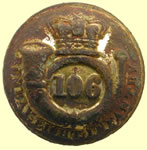 |
106th Regiment button The 106th Regiment of Foot (Bombay Light Infantry) was an infantry regiment of the British Army from 1862 to 1881, when it was amalgamated into The Durham Light Infantry, which was itself later amalgamated into the Rifles. |
||||||
19thC |
108th Regiment of foot button | ||||||
|
1807-1840 |
111 GR is a royal cypher for
George III. |
||||||
1761-1763 |
112th Regiment of foot button (King's Royal Musqueteers) 1761-1763 |
||||||
 |
|||||||
 Prior
to 1767 buttons in the British Army bore no regimental designs or identifications.
The infantry and cavalry were , in 1751, numbered in order of precedence,
the infantry from 1 to 70 and the cavalry, excluding the household cavalry
and dragoon guards from 1st to 13th Dragoons. The infantry after 1751
became know as regiments of foot i.e. 10th Regiment of Foot
Prior
to 1767 buttons in the British Army bore no regimental designs or identifications.
The infantry and cavalry were , in 1751, numbered in order of precedence,
the infantry from 1 to 70 and the cavalry, excluding the household cavalry
and dragoon guards from 1st to 13th Dragoons. The infantry after 1751
became know as regiments of foot i.e. 10th Regiment of Foot
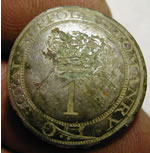
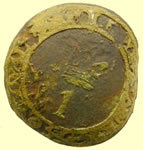
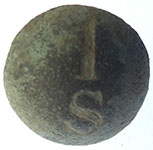

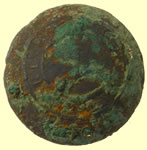
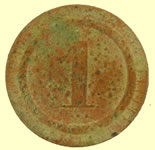
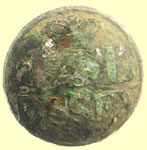
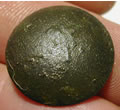


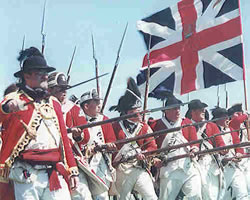

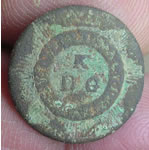
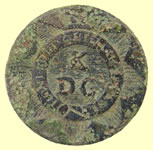

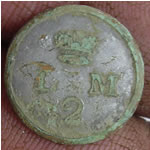

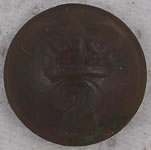
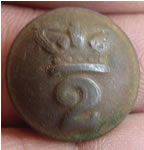
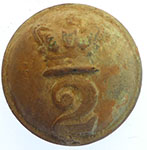
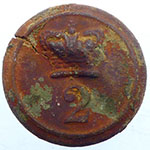



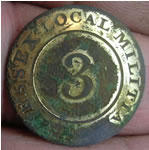
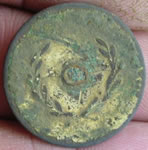
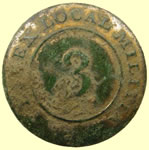
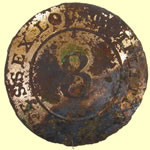
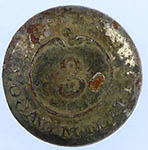
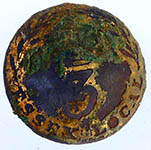
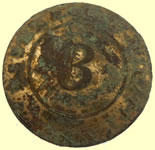

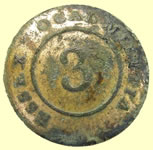




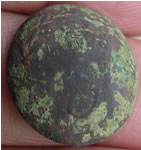
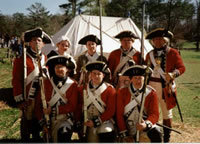
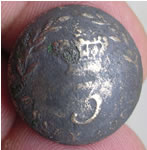


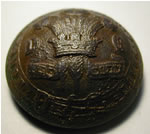
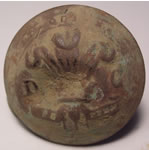
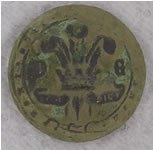
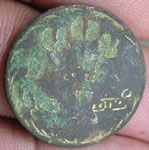
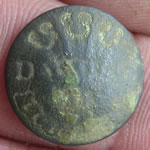
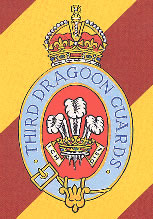
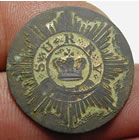
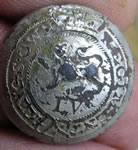
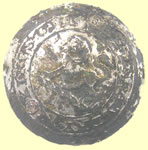
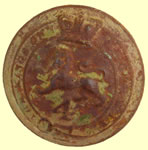
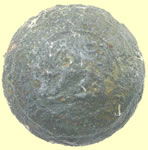




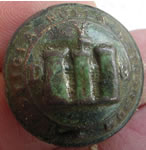
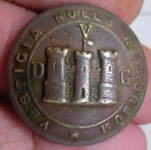
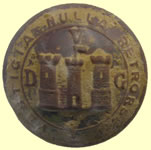
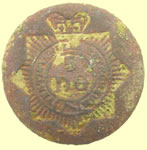
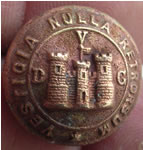
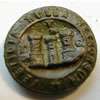


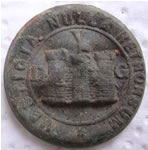
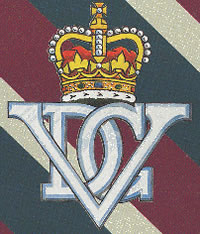
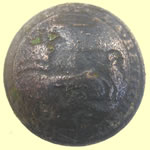
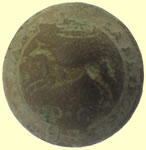
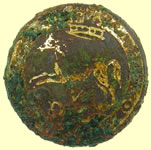
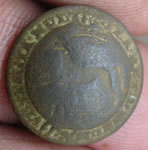
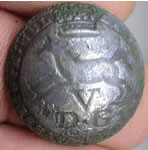
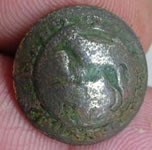

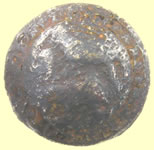
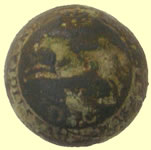

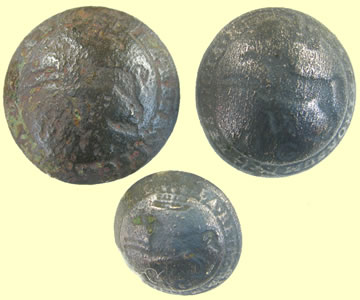

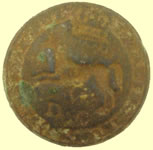
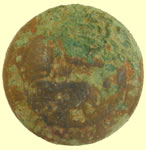
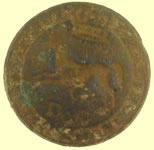

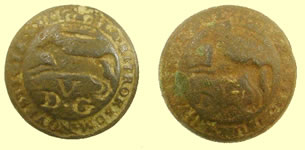
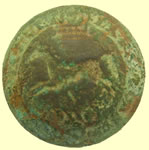
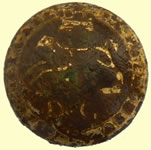

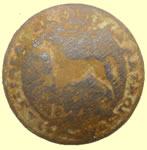


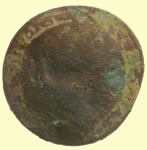
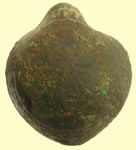
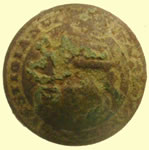

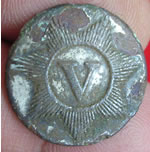

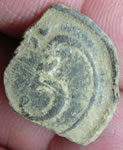

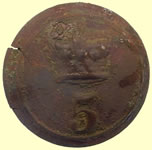
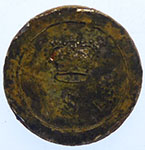
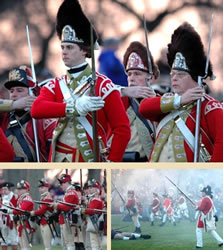


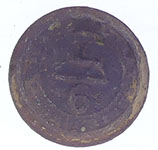

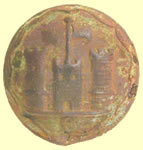
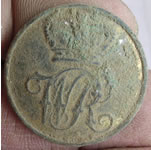
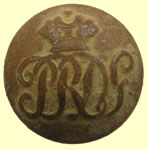
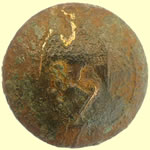
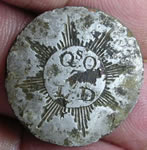
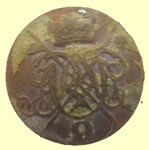

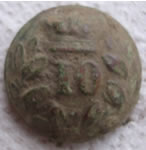
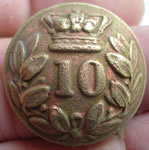

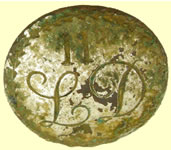


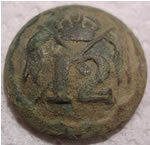

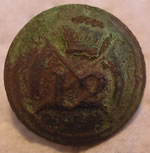
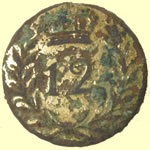
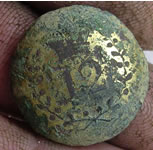
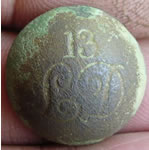
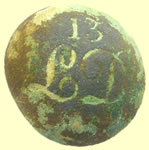



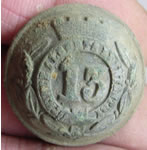

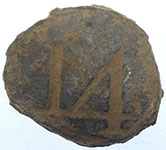

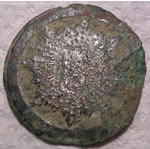
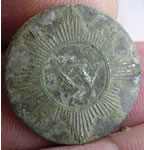
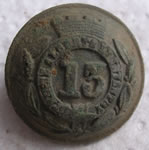

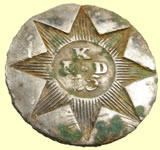

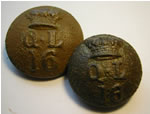


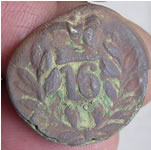
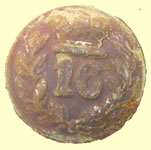


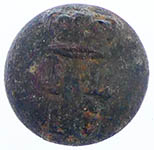
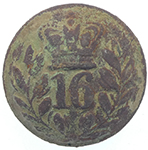
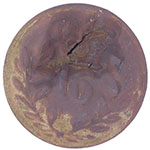
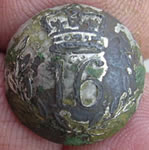
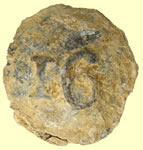
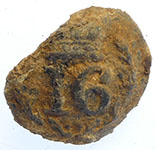
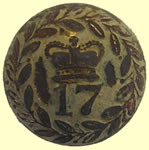

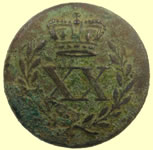
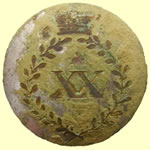
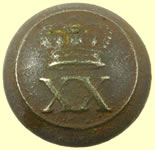
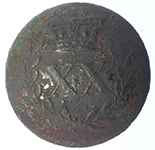


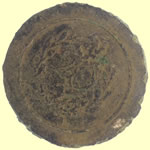


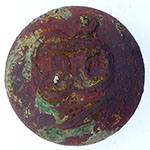
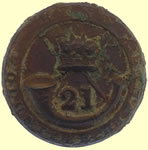
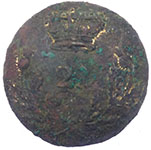
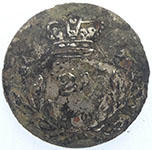

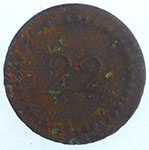
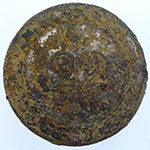


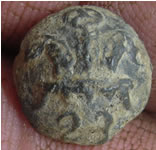
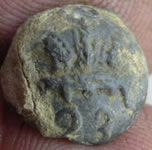

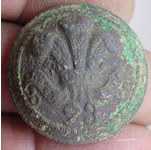

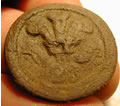
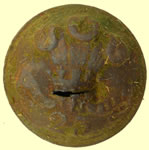

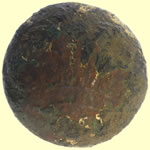

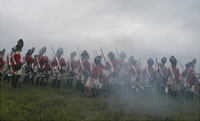
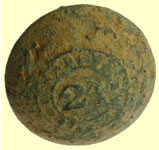
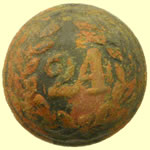
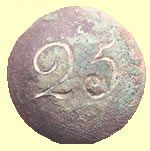
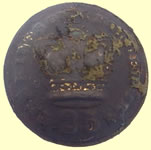
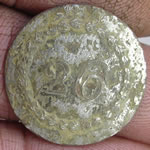

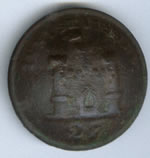
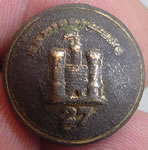
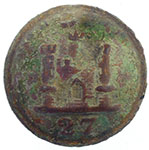
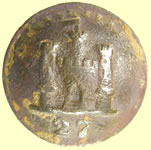

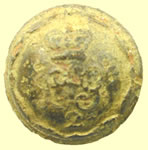
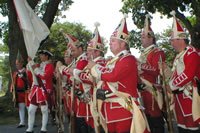
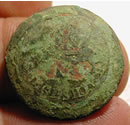


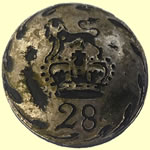
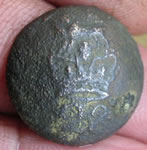
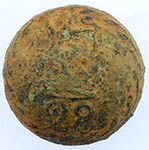
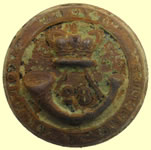
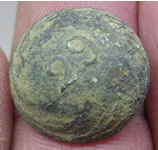

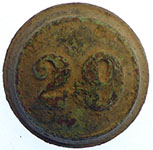
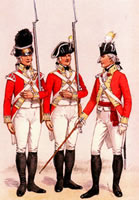 29th
(Worcestershire)
29th
(Worcestershire)